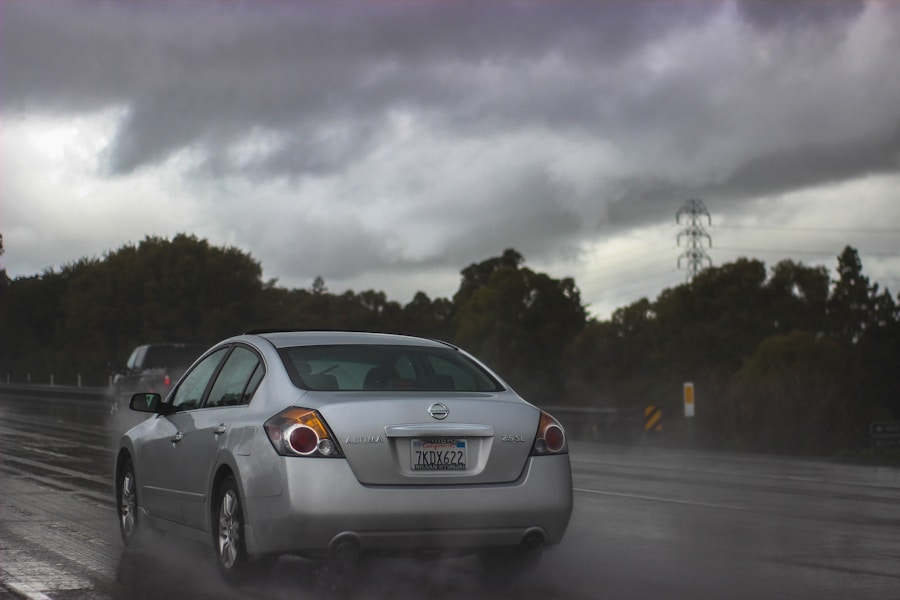Car modification is a practice that has gained immense popularity among automotive enthusiasts and casual drivers alike. At its core, car modification involves altering a vehicle’s original specifications to enhance performance, aesthetics, or functionality. This can range from simple cosmetic changes, such as new paint jobs or custom wheels, to more complex alterations like engine upgrades or suspension modifications.
The motivations behind these modifications can vary widely; some individuals seek to personalize their vehicles, while others aim to improve performance for racing or off-road driving. The world of car modification is vast and diverse, encompassing a wide array of aftermarket parts and accessories. Enthusiasts often delve into the realm of performance tuning, which may include upgrading the exhaust system, installing a turbocharger, or remapping the engine’s electronic control unit (ECU).
Aesthetic modifications can include body kits, custom lighting, and interior upgrades that reflect the owner’s personal style. Importantly, the modification landscape is not limited to performance and aesthetics; it also includes practical enhancements such as improved audio systems or advanced navigation technologies. Each modification carries its own set of implications for the vehicle’s performance, safety, and insurability.
Key Takeaways
- Car modification involves making changes to a vehicle’s appearance or performance.
- Safety concerns with car modification include potential impact on vehicle stability and handling.
- Insurability of modified cars can be affected by the extent of modifications and their impact on safety.
- Common modifications like engine upgrades and suspension changes can impact safety and insurance premiums.
- Ensuring safety and insurability with car modifications involves proper installation and documentation.
Safety Concerns with Car Modification
While car modifications can enhance a vehicle’s appeal and performance, they also raise significant safety concerns. One of the primary issues is that many modifications can alter the vehicle’s handling characteristics. For instance, lowering a car’s suspension may improve its appearance and cornering ability but can also lead to reduced ride quality and increased risk of bottoming out on uneven surfaces.
Similarly, modifications that increase engine power without corresponding upgrades to braking systems can create a dangerous imbalance, making it harder for drivers to control their vehicles in emergency situations. Moreover, certain modifications may inadvertently compromise the structural integrity of the vehicle. For example, removing or altering factory-installed safety features—such as airbags or crumple zones—can significantly increase the risk of injury in the event of an accident.
Additionally, aftermarket parts may not always meet the same safety standards as original equipment manufacturer (OEM) components. This discrepancy can lead to unforeseen failures during operation, further endangering both the driver and other road users. Therefore, it is crucial for car enthusiasts to carefully consider the safety implications of their modifications and ensure that any changes made do not compromise the vehicle’s overall safety profile.
Insurability of Modified Cars

The insurability of modified cars is a complex issue that varies significantly among insurance providers. Many standard auto insurance policies are designed with factory specifications in mind, meaning that modifications can complicate coverage options. When a vehicle is modified, it may no longer fit neatly into the categories defined by insurers, leading to potential gaps in coverage or increased premiums.
Insurers often view modified cars as higher risk due to their enhanced performance capabilities and the likelihood of attracting theft or vandalism.
Some insurers offer specialized policies tailored for modified cars, which can provide more comprehensive coverage options.
These policies may account for the increased value of aftermarket parts and enhancements, ensuring that owners are adequately protected in case of an accident or theft. However, it is essential for car owners to document all modifications thoroughly and retain receipts for aftermarket parts to facilitate accurate valuation and claims processing.
Common Modifications and Their Impact on Safety and Insurance
| Modification | Impact on Safety | Impact on Insurance |
|---|---|---|
| Installing a car alarm | Increases safety by deterring theft | May lead to lower insurance premiums |
| Upgrading to anti-lock brakes | Improves braking performance and control | May result in lower insurance costs |
| Adding a roll cage in a vehicle | Enhances structural integrity and crash protection | May not impact insurance premiums |
| Installing a dash cam | Provides evidence in case of accidents or incidents | May lead to lower insurance premiums |
Among the myriad of modifications available to car enthusiasts, several common alterations stand out due to their popularity and potential impact on safety and insurance. One such modification is the installation of performance tires. While high-performance tires can enhance grip and handling, they may also lead to increased wear on suspension components and potentially affect braking distances.
Insurers may view this modification favorably if it improves safety but could also raise premiums due to the associated risks. Another prevalent modification is engine tuning, which often involves reprogramming the ECU for increased horsepower and torque. While this can significantly enhance a vehicle’s performance, it may also lead to higher insurance costs due to the increased likelihood of accidents associated with higher speeds.
Insurers may require additional assessments or adjustments in coverage based on these changes.
How to Ensure Safety and Insurability with Car Modifications
To ensure both safety and insurability when modifying a vehicle, car owners should adopt a proactive approach that emphasizes research and communication. First and foremost, it is essential to choose reputable aftermarket parts that comply with safety standards. This means selecting components from established manufacturers known for their quality and reliability rather than opting for cheaper alternatives that may compromise safety.
Furthermore, consulting with professionals—such as certified mechanics or automotive engineers—can provide valuable insights into how specific modifications will impact both safety and insurability. These experts can help assess whether proposed changes are appropriate for the vehicle’s intended use and advise on any necessary adjustments to maintain safety standards. Additionally, maintaining open lines of communication with insurance providers is crucial; informing them about modifications before they are made can help ensure that coverage remains adequate and appropriate.
The Role of Insurance Companies in Car Modification

Insurance companies play a pivotal role in shaping the landscape of car modification through their policies and underwriting practices. As modified vehicles often present unique risks compared to their stock counterparts, insurers have developed specific guidelines for assessing these vehicles’ insurability. Many companies require detailed documentation of all modifications made to a vehicle, including receipts for parts and records of installation work performed by certified professionals.
Moreover, insurers may employ specialized adjusters who are knowledgeable about automotive modifications to evaluate claims involving modified vehicles accurately. This expertise allows them to assess whether modifications contributed to an accident or loss accurately. In some cases, insurers may even offer discounts for certain safety-enhancing modifications, such as advanced braking systems or stability control features.
By recognizing the potential benefits of responsible modifications, insurance companies can encourage car owners to make safer choices while still enjoying the personalization that comes with modifying their vehicles.
Legal Considerations for Modified Cars
Legal considerations surrounding modified cars are multifaceted and vary by jurisdiction. Many regions have specific laws governing vehicle modifications to ensure that they meet safety standards and emissions regulations. For instance, certain modifications—such as altering exhaust systems or removing catalytic converters—may violate environmental laws designed to reduce pollution levels.
Failing to comply with these regulations can result in fines or penalties for car owners. Additionally, some jurisdictions require inspections for modified vehicles to ensure compliance with safety standards before they can be legally driven on public roads. This process often involves verifying that all modifications are properly installed and do not compromise the vehicle’s structural integrity or safety features.
Car owners should familiarize themselves with local laws regarding vehicle modifications to avoid legal repercussions and ensure that their vehicles remain roadworthy.
The Future of Car Modification and Insurance
As technology continues to evolve at a rapid pace, the future of car modification and insurance is likely to undergo significant changes. The rise of electric vehicles (EVs) presents new opportunities for modification while also introducing unique challenges for insurers. As more drivers transition to EVs, there will be an increasing demand for aftermarket parts tailored specifically for these vehicles—ranging from performance enhancements to aesthetic upgrades.
Moreover, advancements in telematics and connected car technology may influence how insurers assess risk related to modified vehicles. By leveraging data from onboard systems, insurers could gain insights into driving behavior and vehicle performance that inform premium calculations more accurately than ever before. This shift could lead to more personalized insurance options for modified cars based on actual usage patterns rather than generalized risk assessments.
In conclusion, as car modification continues to evolve alongside advancements in automotive technology and insurance practices, both enthusiasts and insurers will need to adapt to this dynamic landscape. By prioritizing safety, compliance with legal standards, and open communication with insurance providers, car owners can enjoy the benefits of modification while minimizing risks associated with insurability and safety concerns.
Modifying your car can indeed impact its safety and affect your insurance rates. According to a related article on Fairshot Financial’s website, auto insurance can be affected by modifications made to your vehicle. It is important to consider how these changes may impact the overall safety of your car and potentially increase your insurance premiums. It is always best to consult with your insurance provider before making any modifications to your vehicle to ensure you are adequately covered.
FAQs
What are the safety concerns associated with modifying a car?
Modifying a car can potentially compromise its safety features, such as airbags, seatbelts, and structural integrity. Alterations to the vehicle’s suspension, brakes, and tires can also impact its overall safety.
How does modifying a car affect insurance?
Modifying a car can affect insurance premiums, as insurers may consider the alterations when determining the level of risk associated with the vehicle. Some modifications may result in higher premiums, while others may even lead to coverage denial.
What are some common car modifications that can impact safety?
Common car modifications that can impact safety include aftermarket suspension systems, engine modifications, altered exhaust systems, and changes to the vehicle’s weight distribution. These modifications can affect the car’s handling, stability, and overall safety performance.
Are there any safe car modifications that do not affect insurance?
Some car modifications, such as installing safety-enhancing features like backup cameras, parking sensors, and advanced braking systems, may not negatively impact insurance. However, it’s important to consult with the insurance provider to understand the potential effects of any modifications on coverage and premiums.


